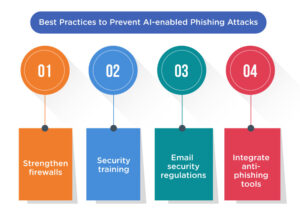Personalization is a buzzword in marketing initiatives today. But have you ever thought about personalized cyber-attacks? Yes, cybercriminals are gradually enhancing their skills with technological aspects, targeting victims in a personalized way. AI-enabled phishing attacks are examples of highly targeted security threats that are taking a toll on businesses lately.
Malicious emails have been key methods of successful cyberattacks for years. As per sources, around 91% of cyber-attacks across the globe are caused by phishing emails, among which spear phishing and whaling are common. With the emergence of AI, phishing emails have experienced major transformations, incorporating hyper-personalization.
Let us understand what AI-enabled phishing attacks are and how these create challenges for businesses.
What are AI-enabled Phishing Attacks?
Phishing attacks include scamming people through email, provoking them to click on suspicious links and download corrupted files, leading to significant data breaches. The emails aim to stimulate curiosity and high interest among receivers. In a similar way, AI-enabled phishing emails are more targeted toward the receivers, for which the technology is used to analyze large amounts of user and company data.
Quicker and impactful analysis offers in-depth information about users, which criminals use to trap individuals. Alongside that, AI helps construct compelling emails that engage people so that they end up making dangerous decisions. Here, AI is utilized to identify accounts, conduct background research on the accounts, design emails, integrate personalization, and incorporate automation in the process.
Currently, over 40% of phishing emails sent are created with the help of AI. Such a statistic is enough to explain how cybercriminals are quickly adopting technology for effective attacks.
How are Cybercriminals Using AI?
Technological advancement has both affirmative and negative sides. AI, in this context, has been supporting businesses in streamlining their operations alongside assisting cybercriminals in advancing their tactics. Integrating AI and ML has allowed threat creators to incorporate sophisticated methods to trap people. The usage of deepfakes, multipurpose attack strategies, and personalized approaches have been greater contributions of AI to enhance cyberattacks.
Sources state that around 74% of the IT security workforce asserts that their companies are in danger of AI-enabled cyber risks. Among such risks, AI-enabled phishing attacks are significant and cause an average loss of $4.88 million following each breach. AI has redefined phishing attacks with added efficiency and impact, provoking one out of five people to click on malicious links.
Besides phishing, cybercriminals use AI for malware generation, password cracking, social engineering, network weakness scanning, and others. Such innovations have doubtlessly offered threat creators enhanced accessibility and the lesser possibility of getting detected. As a result, companies are more often falling prey to such approaches.
How Dangerous can AI-powered Phishing Attacks be for Business?
Phishing attacks are threatening companies of all sizes, causing great financial losses. AI has reinforced such risks with abilities to personalize emails like never before. Such threats possess a high probability of increasing in the forthcoming years, with severe impact and creating more difficulties for organizations.
AI runs on large language models (LLMs) that collect and assess real-time data from diverse sources. Such an approach reveals in-depth information about individuals and companies, offering cyber criminals an opportunity to create significant danger through emails. Messages consisting of valuable information about individuals can provoke people’s concerns and interests. It becomes very difficult for people to overlook such emails.
As a result, they end up clicking on suspicious links and downloading deceitful files. Following such acts, companies can go through several challenges, including data loss, financial damage, operational hurdles, defamation, and others. The recovery time can be significant, such as multiple months and years, based on the damage caused. On many occasions, firms fail to recover and consequently shut down.
Best Practices to Prevent AI-enabled Phishing Attacks:

Creating and reinforcing security firewalls allows companies to safeguard their data from emerging threats. This enables the security team to identify and mitigate malicious events. In emails, such an approach either blocks suspicious accounts or puts them in junk boxes so that individuals stay safe from falling into any danger.
Security training:
Appropriate security training for employees empowers them to identify suspicious activities against them. Therefore, if they receive AI phishing emails, they will be able to recognize them and take the necessary steps to address them. Alongside that, it helps in making informed decisions.
Email security regulations:
Email security regulations allow users to know how to use emails and maintain security. Additionally, it contributes to robust reporting of email activities, strengthening security practices. A few email security protocols or guidelines include HTTPS, SMTP extensions, SSL/TLS, and others.
Integrate anti-phishing tools:
Anti-phishing applications established security gateways for emails sent as well as received. The process includes anti-virus and tool extensions for browsers, adding an extra layer of security.
Articulating the Future of Phishing Attacks and Beyond!
Though organizations are well aware of the cybersecurity environment in contemporary times, AI integration can support attackers in advancing their strategies even further. There is a high possibility that in the upcoming years, AI-enabled phishing attacks will conveniently break email firewalls, scamming individuals. Organizations may also fail to identify such approaches, considering the authenticity and personalized factors.
Under such circumstances, staying alert and adopting effective risk management tactics are the only way out. Therefore, attaining knowledge of AI and cybercrime practices is crucial for companies.
Stay technologically ahead with our other informative blogs!
Recommended For You:
8 Machine Learning Use Cases in Cybersecurity
Cybersecurity for Small Businesses


